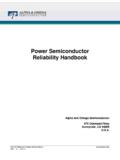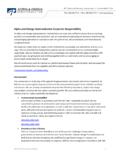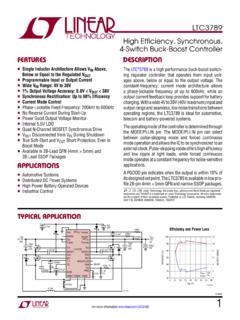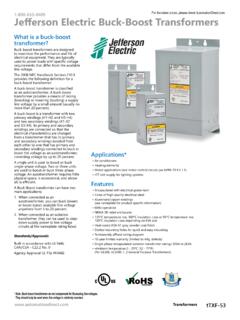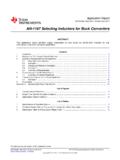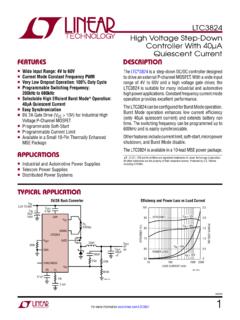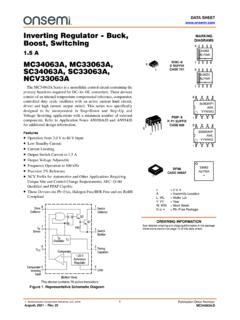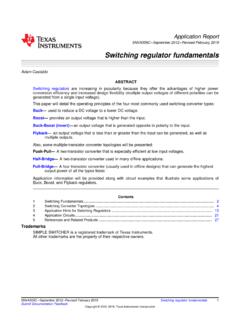Transcription of BUCK Converter Control Cookbook - aosmd.com
1 Application Note PIC-003. buck Converter Control Cookbook Zach Zhang, Alpha & Omega Semiconductor, Inc. A buck Converter consists of the power stage and feedback Control circuit. The power stage includes power switch and output filter. It converts a higher input voltage to a lower output voltage. The feedback Control circuit regulates the output voltage by modulating the power switch duty cycle. Stable operation of switching mode DC/DC Converter requires an adequate loop gain and phase margin in frequency domain. This application note provides an overview of the Control circuit small-signal modeling, power stage modeling and feedback compensation design.
2 1. buck Power Stage Small-Signal Analysis In this application note, the AOZ101X is used as an example to explain Peak Current Mode Control (PCMC) and its small signal analysis. PCMC makes the Converter power stage resemble a voltage-controlled-current-source. It simplifies the feedback compensation design since the complex pole pair associated with output LC filter are removed from the loop compensation equation. PCMC also provides other benefits such as voltage feedback forward and inherent cycle-by-cycle current limit. Simplified buck Converter equivalent circuit Figure 1 below shows a simplified schematic of buck Converter and modulator with Peak-Current-Mode- Control scheme.
3 Figure 1: PCMC buck Converter block diagram August 08 Tel: Fax: 1. Application Note PIC-003. The output voltage is fed back to error amplifier A1 and is compared against the internal reference voltage, Vref, which is for the AOZ101x. Any slight difference between the feedback voltage and reference voltage results in large swing in the error amplifier output voltage. The output voltage of error amplifier A1 is also called Control voltage, which actually controls the switch current level and the output voltage. The inductor ripple current is translated into a ramp voltage signal by the current sense amplifier A2, which amplifies the voltage drop across the high side switch.
4 This ramp represents the inductor current plus compensation ramp signal together and is fed back to the PWM comparator, forming an inner current Control loop. At the beginning of each switching period, Control voltage is higher than the current signal voltage. The output of the PWM. comparator is high and the high-side switch is on. The input voltage applies to the output filter inductor, L. The inductor current increases at a constant slew rate decided by input voltage, output voltage, inductance and switching frequency. The inductor current ramp up slew rate is: IL is the peak to peak inductor current ripple. ton is the high-side switch turn on time.
5 The current signal voltage ramps up as the switch current increasing. When the current signal voltage, V Isn, equals to the Control voltage VC, the PWM comparator output changes from high to low. The high-side switch turns off and inductor current starts to decay. The inductor current ramp down slew rate is: toff is the high side switch turn off time. As explained above, Control voltage signal, VC, is compared against current sense signal and determines the peak inductor current level. Higher VC regulates peak inductor current to higher level. If VC is zero, inductor current is regulated to zero. If inductor is not saturated, there is a constant difference between average inductor current and peak inductor current.
6 Where IL_peak is the peak inductor current; IL_average is the average inductor current, it is also the output current. The Control voltage, VC, controls peak inductor current. If the inductor ripple current IL is small, VC also controls average inductor current. So the output filter inductor and PWM comparator together can be simplified to a Voltage-Controlled- Current-Source. The simplified buck Converter power stage circuit is shown in Figure 2 below. August 08 Tel: Fax: 2. Application Note PIC-003. Figure 2: Equivalent circuit of buck Converter with CMC. The current sense amplifier, A2, has a transconductance GCS, which is defined as: Assuming the inductance is large enough and ripple can be ignored, the inductor current is same as the load current.
7 Since the Control voltage regulates the inductor current level, the VIsn in equation above can be replaced by Control voltage VC. Then Control voltage can be calculated using inductor current, output voltage and current sense circuit transconductance in the equation below. Power stage open loop transfer function The power stage open loop transfer function is defined as the transfer function from Control voltage to output voltage. From Figure 2 above, VO can be calculated easily by multiplying output current and output impedance as below. CO is the output capacitor. RCO is the output capacitor ESR. RL is the load resistance. Combine the two equations above to get power stage open loop transfer function.
8 August 08 Tel: Fax: 3. Application Note PIC-003. since RL>>ESR, Now it can be found that power stage open loop transfer function has one pole and one zero. The pole is called dominant pole or load pole: The zero is called ESR zero: The power stage transfer function has DC gain: Figure 3 below shows the bode plot of power stage open loop transfer function. The dash line and solid line show the bode plots when Converter is under light load and heavy load respectively. As load increases, load resistance RL decreases. The load pole moves from low frequency to high frequency. Also, the open loop transfer function DC gain is reduced as load current increases.
9 Figure 3: Bode plot of buck Converter power stage 2. Compensation Circuit Small Signal Analysis and Feedback Design AOZ101x buck regulator IC uses a high bandwidth transconductance amplifier as error amplifier A1. A transconductance amplifier is actually a Voltage-Controlled-Current-Source. It converts any error voltage at its input pins to a current flowing out of its output pin. The amplifier factor, Gea, is called transconductance gain. It is defined as: August 08 Tel: Fax: 4. Application Note PIC-003. A transconductance amplifier block diagram and equivalent circuit are shown in Figure 4 below. Figure 4: Transconductance amplifier and equivalent circuit In Figure 4 above, Ramp represents the output impedance of transconductance amplifier.
10 An ideal transconductance has infinite output impedance, Ramp. For the transconductance amplifier in AOZ101x series IC, the output impedance is above . RC and CC represent the external compensation RC network components. From AC point of view, the non-inverting pin of amplifier is connected to a DC reference voltage, which is a virtual AC. ground. Figure 5 below shows the simplified compensation circuit, which is part of the buck Converter block diagram shown in Figure 2. Figure 5: Compensation circuit diagram August 08 Tel: Fax: 5. Application Note PIC-003. The transfer function of the compensation circuit in Figure 5 is derived below. Where is the voltage feedback divider gain, and Since Ramp>>RC.

